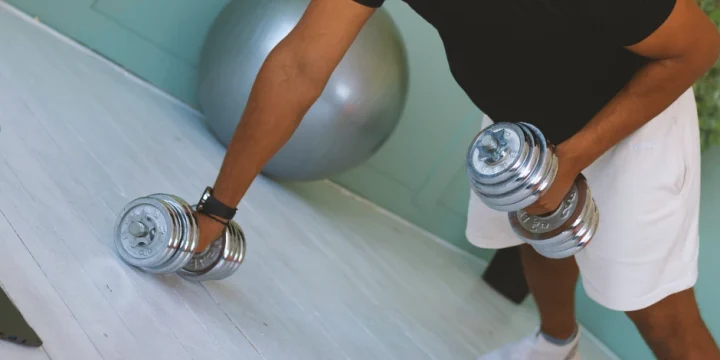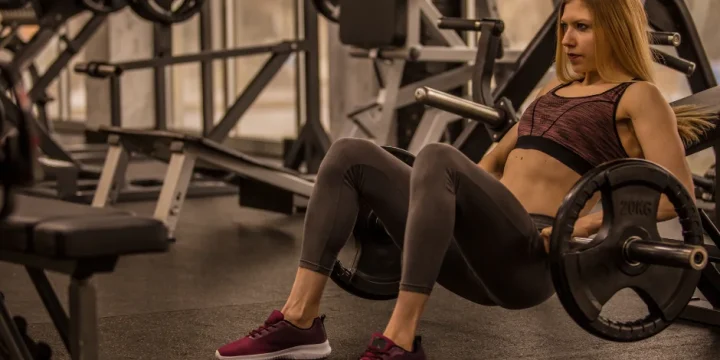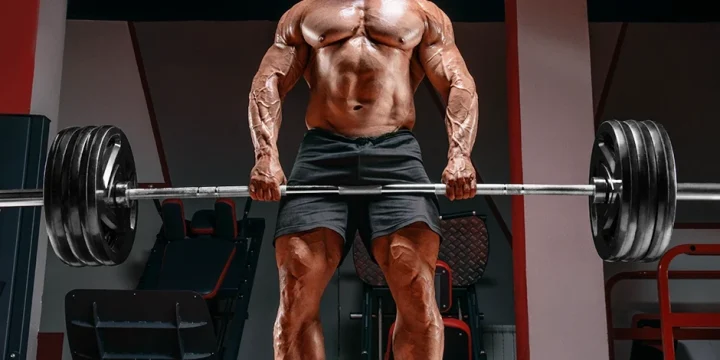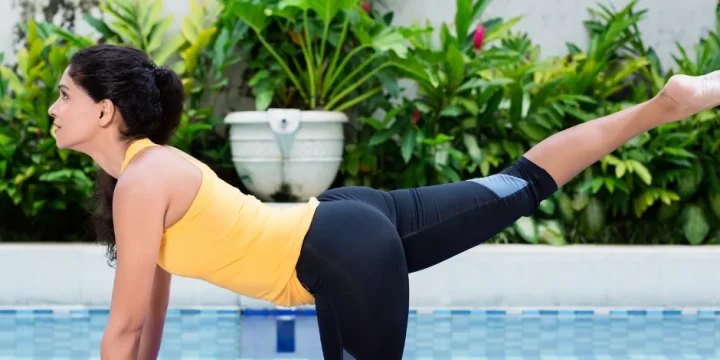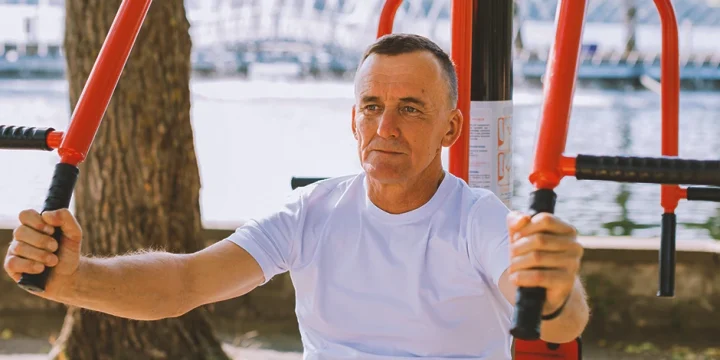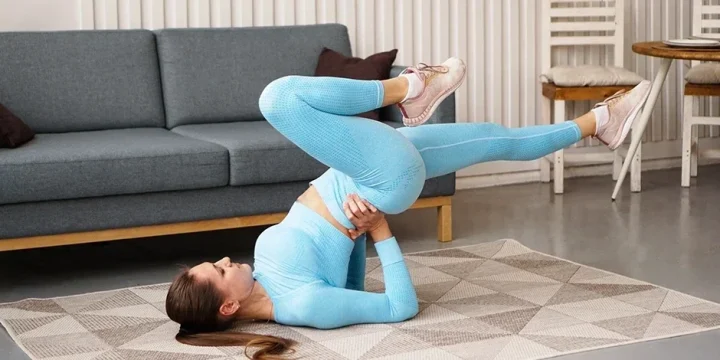Not all exercises are equally effective; some may do more harm than good, leading to joint problems and back pain. What may seem like an innocuous exercise today could have repercussions in the future.
Drawing from my experience as a personal trainer and with the help of our physical therapist, I compiled thirteen of the worst exercises you should skip.
We also gathered alternative exercises targeting the same muscles without compromising your form or causing potential injuries that you should incorporate into your exercise routine.
Quick Summary
- The worst exercises include dumbbell side bends, behind-the-neck presses, barbell jump squats, behind-the-neck lat pulldowns, hip abduction machines, sit-ups, smith machines, bicep curls, upright rows, leg extensions, supermans, kipping pull-ups, and chair dips.
- The biggest workout mistakes to avoid include not warming up, lifting too much weight, and overtraining the same muscles.
- Certain exercises, like the hip abduction machine, might appear beneficial for toning glutes, yet a study in the Journal of Orthopaedic and Sports Physical Therapy reveals they can lead to injuries like iliotibial band syndrome.
- In my opinion, the emphasis on choosing safer, alternative exercises and focusing on proper form is crucial for both injury prevention and achieving effective fitness results.
13 Worst Exercises to Avoid

1. Behind the Neck Presses
Incorporating Behind the Neck Presses into your workout routine puts excessive pressure on your shoulder muscles.
It can lead to undesired shoulder and neck pain, especially if you have poor shoulder mobility.
Instead, you can switch to a safer, more effective alternative like the Arnold press.
This is a great exercise to target multiple muscles (shoulders, arms, and chest). Remember not to overextend your back to avoid injuries.
How to do the Arnold press:
- Stan with your legs shoulder-width apart.
- Hold a pair of dumbbells in front of you with your palms facing your shoulders.
- Push the dumbbells over your head while rotating your palm away from your body.
- Straighten your arms, and pause for one to three seconds.
- Lower in control and reverse the pattern.
- Repeat until you reach the desired number of reps.
2. Behind-the-Neck Lat Pulldowns
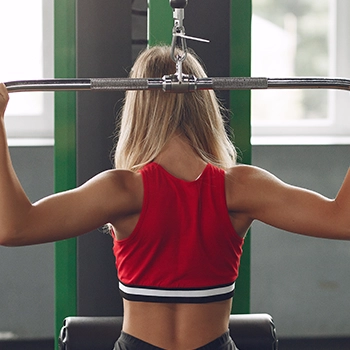
This exercise can put undue strain on your muscles and spine from the forward craning of the neck and unnatural shoulder rotation.
Front of the Neck Lat Pulldowns is proven to be more efficient in muscle stimulation.
According to The National Institute of Health (NIH), with this lat pulldown alternative, you can feel confident that your muscles are targeted efficiently without risking injury [1].
I advise to use proper form to not put excessive pressure on the lower back and pelvis.
How to do lat pulldowns:
- Set up the weight to your desired amount of resistance and adjust the pad to sit on your thighs.
- Place your hands outside the bend of the bar.
- Sit down ensuring your torso is upright and pull down to the top of the chest.
- Pause for one to three seconds, then push your arms back up under control.
- Repeat until you reach the desired amount of reps.
3. Dumbbell Side Bends
One of the main drawbacks of this exercise is that it involves excessive lateral bending and spine twisting, which will put unwanted strain on other parts of the body.
Maintaining your spine properly aligned can be challenging, which is crucial for isolating the obliques and getting the most out of the exercise.
If you want to engage your core muscles without putting undue stress on your spine, I recommend hanging oblique knee raises instead.
This exercise allows you to target your obliques while boosting your balance level.
It is essential to maintain steadiness in the movement as a swing-like movement can cause injuries.
How to do the hanging oblique knee raises:
- Hang on a pull-up bar. Keep your body straight and your feet and knees together.
- Move the legs upward, keeping your knees in line with your right arm creating a ninety degrees angle with your hips.
- Slowly retract them back down to the starting position to alternate to the left arm side in the same manner.
- Repeat until you reach the desired number of reps.
“The hanging knee raise is an efficient and effective core exercise that increases functional strength, muscular development, and control in your abdominal muscles. This exercise is great for improving grip strength since you’re hanging by your own grip throughout each set.”
- Tyler Read, Editor at Healthline.com
4. Hip Abduction Machine
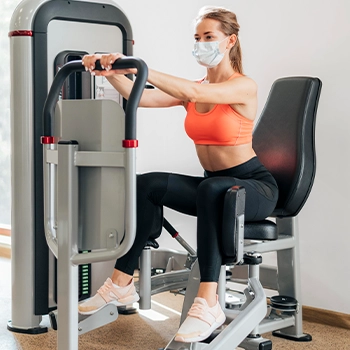
It may seem like a great exercise for shapely glutes, but a study from the Journal of Orthopaedic and Sports Physical Therapy shows that it can cause injuries such as iliotibial band syndrome [2].
If you want to build booty gains and prevent injuries, ditch the hip abduction machine and try some functional exercises that mimic natural movement patterns, such as squats, hip thrusts, and deadlifts with a resistance band.
How to do banded hip thrusts:
- Sit on a bench and loop each end of the resistance band around your feet. Then, center the band in the middle.
- Grab the band in a U-shape, pull it up onto your knees and sit it down on your waist.
- Keep your knees in a 90-degree position, scoot away from the bench, and get the middle of your back onto the bench, while keeping your feet underneath your knees.
- Thrust your hips forward and pause for three seconds while squeezing your glutes.
- Bring your hips back down to return to the starting position.
- Repeat until you reach the desired number of reps.
5. Barbell Jump Squats
Barbell jump squats can put a strain on your lower back and joints. Body weight jump squats or adjusting the placement of the weight can help you achieve the benefits of barbell jump squats without discomfort.
How to do jump squats:
- Place your feet slightly wider than hip-width apart.
- Lower yourself into a squat, keeping the pressure on the hips and glutes, and bringing your hands in front of you.
- Push through your heels to jump up.
- Land softly to go back to the squatting position.
- Repeat for the recommended number of repetitions.
“This exercise uses your lower body muscles as well as your core: abdominals, glutes, hamstrings, and lower back. The squat jump exercise ranks near the top of the list for developing explosive power using only an athlete's body weight.”
- Elizabeth Quinn, Editor at Verywellfit.com
6. Sit-Ups
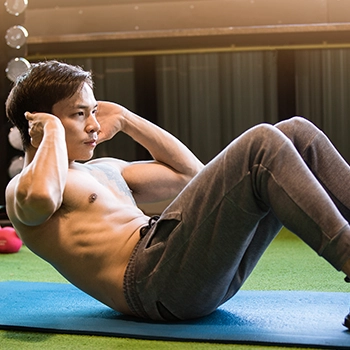
As a trainer, I advise caution with sit-ups as they are not a functional movement for the human body and can risk spinal health due to repetitive midline flexion.
Additionally, for clients dealing with Diastasis Recti or kyphosis, sit-ups can worsen these conditions.
As an alternative, try incorporating leg lifts into your exercise routine - they are a safer and more effective way to strengthen your core without harming your spine.
How to do leg lifts:
- Lay on your back, place your hands by your sides and head relaxed firmly on the ground.
- Keep your back firmly pressed to the floor and extend your legs up.
- Slowly lower the legs halfway.
- Repeat as many reps as you comfortably can.
7. Smith Machine
The Smith machine is considered unsafe due to its increased risk of injury as it forces your body into a fixed bar path, which can lead to suboptimal positions and overloading of the joints.
Removing the major benefits of free weights, such as the need for stabilization, the smith machine restricts natural movement and can lead to accidents.
Instead, it's recommended to use alternative equipment such as kettlebells, resistance bands and dumbbells.
Functional movements like pulls, presses, squats, and lunges allow for a more natural range of motion and reduce the chance of injury.
How to do a dumbbell squat:
- Stand up straight holding a dumbbell in each hand with your feet hip-width apart and toes slightly pointing outwards while.
- Inhale as you slowly lower your torso by bending the knees until your thighs are parallel to the floor while maintaining a straight posture.
- Exhale as you straighten your leg to go back to the starting position.
- Repeat until you reach the desired number of reps.
8. Upright Row
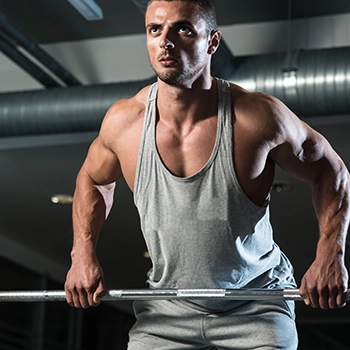
The upright row can put unnecessary pressure on your nerves when you lift the weight toward your chin, potentially leading to a rotator cuff injury.
Fortunately, there's a safer alternative: the face pull with a rope attachment.
How to do face pull with a rope attachment:
- Set up your pulley so that it’s about chest height.
- Stand with feet shoulder-width apart, grab the rope attachment with an overhand grip, and take two steps back facing the pulley.
- Pull the rope towards your face while keeping the elbows higher than your wrists.
- Come back forward to the starting position.
- Repeat as many reps as you comfortably can.
9. Bicep Curl
The bicep curl comes with some potential drawbacks related to posture and form as your shoulders are forced into an extreme level of internal rotation.
As a result, your rotator cuff is placed in a compromised position, increasing the likelihood of shoulder impingement and discomfort.
Additionally, the bicep curl exercise doesn't offer the full range of motion that a weight-based curl does.
For a safe and effective way to tone your biceps, you may want to consider bicep curls with dumbbells.
How to do a bicep curl with dumbbells:
- Hold one dumbbell in each hand, place your arms in a neutral position hanging by your sides, and stand with your feet hip-width apart.
- Curl the dumbbells up to your shoulder level while keeping a relaxed and stable upper body.
- Rotate your hands back down to the starting position.
- Perform the desired repetitions.
“This exercise is generally recommended for most people. But if you have an arm injury or experience pain during the motion, do not continue. You can expect to feel fatigue and even burning in your biceps and forearm muscles after a few lifts, and this is desired to get your muscles to strengthen and grow.”
- Paul Rogers, Editor at Verywellfit.com
Related Articles:
10. Leg Extensions
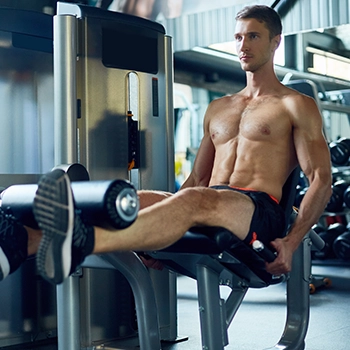
Leg extensions put unnecessary tension on the anterior cruciate ligament and increase the risk of patella displacement, but it also places maximal force on the thinnest portion of your knee cartilage called the knee cap.
Exercises such as squats, deadlifts, lunges, and Bulgarian split squats offer safer and more effective options for those seeking to strengthen their quads and glutes.
How to do a lunge:
- Place one foot in front of the other.
- Drop your upper body straight down with your chest up and knees behind your toes.
- Repeat until you reach the desired amount of reps and switch to the other leg.
11. Superman
This exercise can cause back pain as it forces your lower back to overextend repetitively.
The reverse back extension is a safer alternative that doesn’t contribute to bad patterns and won't force your lower back to overextend.
How to do reverse back hyperextension:
- Lay face down on a hyperextension machine or bench with your hips against the hip support pad and hands holding the ankle pads.
- Extend your legs until your body is parallel to the floor.
- Hold for a second then bring your legs back toward the base of the bench to return to the starting position.
- Repeat reverse hyperextension until you reach the desired amount of repetitions.
12. Kipping Pull-Ups
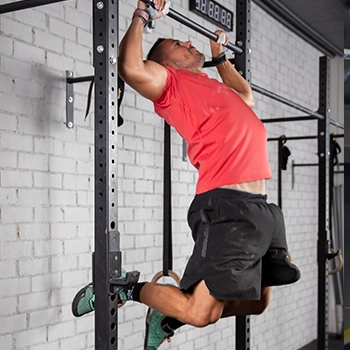
The kipping pull-ups can put a lot of stress on your shoulders as you’re hanging from a bar. Instead, opt for the conventional pull-up.
It is a more beneficial exercise without risking injury.
How to do pull-ups:
- Place your hands on a bar shoulder-width apart with your palm facing forward.
- Pull your body weight up towards the bar until the bar is at chin level
- Lower yourself back down in a controlled manner until your arms are fully extended.
- Repeat as many reps as you comfortably can.
13. Chair Dips
Bench/chair dips can harm your shoulder joints due to the internal rotation of your shoulders.
To prevent any potential injury or discomfort, try incorporating triceps extensions to target those muscles without unnecessary strain.
How to do triceps extension:
- Stand or sit down on a bench and grab one dumbbell.
- Bring the weight over your head. Keeping your elbows close to your ears and pointing forward, fully extend both arms.
- Slowly lower the weight, bringing the dumbbell behind your head.
- Come back up to reverse the movement.
“Doing the triceps extension while standing challenges you to engage the core to stabilize the lower and mid-body while you move both arms simultaneously over your head.”
- Malia Erey, Personal Trainer & Editor at Verywellfit.com
What Are the Biggest Workout Mistakes to Avoid?

As a trainer, I often see the biggest workout mistakes: using poor form, skipping warm-ups, lifting beyond one's capacity, holding breath during exercises, and neglecting recovery periods.
1. Using Poor Form
It’s easy to get carried away with your workout routine and rush through each exercise without proper form.
Pay attention to how you move during each exercise as incorrect form can lead to joint pain or even severe injuries in the long run.
2. Not Warming Up
Before any training, it is essential to warm up with bodyweight dynamic stretches like arm circles or squats.
Don’t forget to give yourself a few minutes after the workout to cool down with static stretches like hamstring stretching or foam rolling.
3. Neglecting Recovery

Working out needs energy, so it's key to take breaks between sessions for muscle recovery and rebuilding.
Shoot for 1-2 rest days weekly, based on how active you are. Resting between sets lets your body and mind bounce back from exercise stress.
In these breaks, muscles repair, regain strength, and gear up for the next round. Skipping rest can lead to tiredness and a higher injury risk.
For solid recovery, take at least a minute's break between sets. This ensures peak results and dodges muscle pain or burnout.
4. Improper Breathing
When you don’t breathe correctly, it can cause your heart rate to spike and negatively affect the quality of your workout.
When lifting weights, for example, you should always exhale as you lift the weight and then inhale as you lower the weight.
This will help ensure proper oxygen flow throughout your body and help prevent fatigue.
Additionally, make sure that you’re taking deep breaths during cardio exercises like running or cycling to keep your heart rate in check and positively affect the quality of your workout.
5. Lifting Heavier than Your Max Capacity
This is one of the most common mistakes I notice at the gym.
Starting too intense can lead to burnout or even injury.
Start slowly and gradually increase intensity over time rather than going all out immediately.
Comparison with Compound Movements
Contrasting the 'worst exercises' with compound movements can significantly enhance the depth and value of your article. Here's how you can approach this:
- Efficiency of compound movements: Compound exercises, like squats, deadlifts, and bench presses, work multiple muscle groups simultaneously. This efficiency means you can achieve more in less time compared to isolated exercises often listed among the 'worst', like tricep kickbacks or sit-ups, which target limited muscle groups.
- Functional benefits: Compound movements often mimic everyday activities or athletic movements, making them more functional than many of the 'worst exercises'. For example, a squat is a fundamental human movement used daily, unlike the unnatural motion of a behind-the-neck pulldown.
- Safety and balance: Compound exercises promote balanced muscle development, reducing the risk of injuries caused by muscle imbalances. In contrast, some of the 'worst exercises' can lead to imbalances or strain due to their unnatural movement patterns or excessive focus on a single muscle group.
- Joint health: Many compound movements, when performed correctly, distribute stress across multiple joints, reducing the risk of overloading a single joint. This is in stark contrast to exercises like upright rows, which can put excessive strain on the shoulder joints.
- Overall strength and stability: Compound exercises enhance overall body strength and stability. They engage core muscles and stabilizers, offering a more holistic workout compared to the isolated and often less effective 'worst exercises'.
FAQs
Are There Exercises that Beginners Should Avoid?
Exercises that beginners should avoid are smith machine squats, sit-ups, behind-the-neck lat pulldowns, abductor machines, leg extension machines, ballistic stretches, and crunches.
What Exercises Have the Highest Risk of Injury ?
Exercises that have the highest risk of injury are bicycle crunches, kettlebell swings, bent-over rows, Romanian deadlifts, overhead squats, good mornings, pull-ups, and preacher curls.
References:
- https://pubmed.ncbi.nlm.nih.gov/19855327/
- https://www.jospt.org/doi/10.2519/jospt.2010.3337
About The Author
You May Also Like
